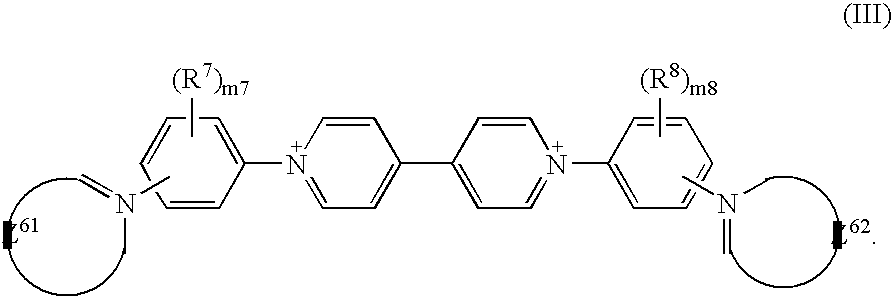Optical information recording medium and method of recording information
a technology of optical information and recording medium, which is applied in the field of heat mode optical information recording medium, can solve the problems of increasing jitter and compromising recording characteristics, and achieve the effect of good jitter and little thermal interferen
- Summary
- Abstract
- Description
- Claims
- Application Information
AI Technical Summary
Benefits of technology
Problems solved by technology
Method used
Image
Examples
synthesis example 1
[0109]Dye D-5 was synthesized by the following synthesis method.
[0110](1) Synthesis of Hydrochloride of Cation Compound
[0111]Synthesis was conducted by the following scheme:
[0112](i) Synthesis of Intermediate A
[0113]To a solution of 15 g of 4,4′-bipyridyl in 100 mL of acetone was added 13.2 g of 1-chloro-2,4-dinitrobenzene. The mixture was stirred for 15 minutes at room temperature and then hot refluxed for 15 hours. When the reaction had ended, the mixture was allowed to cool to room temperature and the precipitating crystals were recovered by filtration under reduced pressure. Finally, the crystals obtained were washed with acetone and dried, yielding 18.8 g of intermediate A.
[0114](ii) Synthesis of Intermediate B
[0115]To a suspension of 14.4 g of intermediate A in 100 mL of acetonitrile was added 4.6 g of aniline and the mixture was hot refluxed for 7 hours. When the reaction had ended, the mixture was allowed to cool to room temperature, and the precipitating crystals were recov...
synthesis example 2
[0124]
[0125]Dye D-57 was synthesized according to the following scheme by the method described in Japanese Unexamined Patent Publication (KOKAI) No. 2002-59652, which is expressly incorporated herein by reference in its entirety (absorption λmax=561.7 nm, ε=3.15×105 / 2,2,3,3-tetrafluoropropanol (TFP)).
[0126]1H-NMR data of dye D-57 (d6-DMSO): 11.57 (s, 2H), 9.72 (d, 4H), 9.07 (d, 4H), 8.52 (s, 2H), 8.03-8.10 (m, 6H), 7.48-7.71 (m, 12H), 7.10-7.21 (m, 4H), 2.00 (s, 8H), 1.76-1.81 (m, 4H), 1.53 (s, 6H), 1.33-1.47 (m, 4H), 0.88 (t, 6H)
Measurement of Film-Softening Temperature
[0127]The film-softening temperature of dyes D-5 and D-57, as well as dyes 1 and 2, described further below, were measured by the method given below. The film-softening temperatures that were measured are given in Table 2.
[0128](Method of Measuring Film-Softening Temperature)
[0129]A 20 mg quantity of dye was dissolved in 1 mL of tetrafluoropropanol. This solution was coated to a glass support by spin coating (coating...
example 1
Manufacture of Optical Information Recording Medium
[0130]Polycarbonate resin was injection molded to form a support with a diameter of 120 mm, a thickness of 0.600 mm, and spiral grooves (depth: 140 nm, groove width: 365 nm, track pitch: 0.74 micrometer). This support was employed to form a recording layer. A coating liquid comprised of a solution of 1.00 g of dye D-5 in 100 mL of 2,2,3,3-tetrafluoropropanol was prepared. This coating solution was coated by spin coating to the surface of the support on which the grooves had been formed to form a dye layer. Next, AgNdCu alloy (target composition: Ag 98.4 atom percent, Nd 0.7 atom percent, Cu 0.9 atom percent) was sputtered onto the dye layer to form a reflective layer 120 nm in thickness. The surface of the above disk on the reflective layer side and a separately prepared polycarbonate resin support 120 mm in diameter and 0.600 mm in thickness were bonded with an adhesive in the form of a UV-curable resin (Daicure Clear SD640 made by...
PUM
| Property | Measurement | Unit |
|---|---|---|
| film-softening | aaaaa | aaaaa |
| linear recording velocity | aaaaa | aaaaa |
| groove depth | aaaaa | aaaaa |
Abstract
Description
Claims
Application Information
 Login to View More
Login to View More - R&D
- Intellectual Property
- Life Sciences
- Materials
- Tech Scout
- Unparalleled Data Quality
- Higher Quality Content
- 60% Fewer Hallucinations
Browse by: Latest US Patents, China's latest patents, Technical Efficacy Thesaurus, Application Domain, Technology Topic, Popular Technical Reports.
© 2025 PatSnap. All rights reserved.Legal|Privacy policy|Modern Slavery Act Transparency Statement|Sitemap|About US| Contact US: help@patsnap.com



